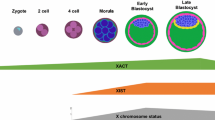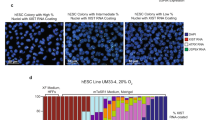Abstract
Since the groundbreaking hypothesis of X chromosome inactivation (XCI) proposed by Mary Lyon over 50 years ago, a great amount of knowledge has been gained regarding this essential dosage compensation mechanism in female cells. For the mammalian system, most of the mechanistic studies of XCI have so far been investigated in the mouse model system, but recently, a number of interesting XCI studies have been extended to human pluripotent stem cells, including both embryonic stem cells (ESCs) and induced pluripotent stem cells (iPSCs). Emerging data indicate that XCI in hESCs and hiPSCs is much more complicated than that of their mouse counterparts. XCI in human pluripotent stem cells is not as stable and is subject to environmental influences and epigenetic regulation in vitro. This mini-review highlights the key differences in XCI between mouse and human stem cells with a greater emphasis placed on the understanding of the epigenetic regulation of XCI in human stem cells.

Similar content being viewed by others
References
Agrelo R, Wutz A (2010) X inactivation and disease. Semin Cell Dev Biol 21:194–200
Brown CJ, Ballabio A, Rupert JL, Lafreniere RG, Grompe M, Tonlorenzi R, Willard HF (1991) A gene from the region of the human X inactivation centre is expressed exclusively from the inactive X chromosome. Nature 349:38–44
Bruck T, Benvenisty N (2011) Meta-analysis of the heterogeneity of X chromosome inactivation in human pluripotent stem cells. Stem Cell Res 6:187–193
Cheung AY, Horvath LM, Grafodatskaya D, Grafodatskaya D, Pasceri P, Weksberg R, Hotta A, Carrel L, Ellis J (2011) Isolation of MECP2-null Rett Syndrome patient hiPS cells and isogenic controls through X-chromosome inactivation. Hum Mol Genet 20:2103–2115
Dhara SK, Benvenisty N (2004) Gene trap as a tool for genome annotation and analysis of X chromosome inactivation in human embryonic stem cells. Nucleic Acids Res 32:3995–4002
Dvash T, Fan G (2009) Epigenetic regulation of X-inactivation in human embryonic stem cells. Epigenetics 4:19–22
Dvash T, Lavon N, Fan G (2010) Variations of X chromosome inactivation occur in early passages of female human embryonic stem cells. PLoS One 5:e11330
Enders AC, Schlafke S (1981) Differentiation of the blastocyst of the rhesus monkey. Am J Anat 162:1–21
Enders AC, Schlafke S, Hendrickx AG (1986) Differentiation of the embryonic disc, amnion, and yolk sac in the rhesus monkey. Am J Anat 177:161–185
Guo G, Yang J, Nichols J, Hall JS, Eyres I, Mansfield W, Smith A (2009) Klf4 reverts developmentally programmed restriction of ground state pluripotency. Development 136:1063–1069
Hall LL, Byron M, Butler J, Becker KA, Nelson A, Amit M, Itskovitz-Eldor J, Stein J, Stein G, Ware C, Lawrence JB (2008) X-inactivation reveals epigenetic anomalies in most hESC but identifies sublines that initiate as expected. J Cell Physiol 216:445–452
Hanna J, Cheng AW, Saha K, Kim J, Lengner CJ, Soldner F, Cassady JP, Muffat J, Carey BW, Jaenisch R (2010) Human embryonic stem cells with biological and epigenetic characteristics similar to those of mouse ESCs. Proc Natl Acad Sci USA 107:9222–9227
Heard E, Disteche CM (2006) Dosage compensation in mammals: fine-tuning the expression of the X chromosome. Genes Dev 20:1848–1867
Hochedlinger K, Plath K (2009) Epigenetic reprogramming and induced pluripotency. Development 136:509–523
Huynh KD, Lee JT (2005) X-chromosome inactivation: a hypothesis linking ontogeny and phylogeny. Nat Rev Genet 6:410–418
Lengner CJ, Gimelbrant AA, Erwin JA, Cheng AW, Guenther MG, Welstead GG, Alagappan R, Frampton GM, Xu P, Muffat J, Santagata S, Powers D, Barrett CB, Young RA, Lee JT, Jaenisch R, Mitalipova M (2010) Derivation of pre-X inactivation human embryonic stem cells under physiological oxygen concentrations. Cell 141:872–883
Luckett WP (1978) Origin and differentiation of the yolk sac and extraembryonic mesoderm in presomite human and rhesus monkey embryos. Am J Anat 152:59–97. doi:10.1002/aja.1001520106
Lyon MF (1961) Gene action in the X-chromosome of the mouse (Mus musculus L.). Nature 190:372–373
Lyon MF (1962) Sex chromatin and gene action in the mammalian X chromosome. Am J Hum Genet 14:135–148
Maherali N, Sridharan R, Xie W, Utikal J, Eminli S, Arnold K, Stadtfeld M, Yachechko R, Tchieu J, Jaenisch R, Plath K, Hochedlinger K (2007) Directly reprogrammed fibroblasts show global epigenetic remodeling and widespread tissue contribution. Cell Stem Cell 1:55–70
Makhlouf M, Rougeulle C (2011) Linking X chromosome inactivation to pluripotency: necessity or fate? Trends Mol Med. doi:10.1016/j.molmed.2011.02.001
Marchetto MC, Carromeu C, Acab A, Yu D, Yeo GW, Mu Y, Chen G, Gage FH, Muotri AR (2010) A model for neural development and treatment of Rett syndrome using human induced pluripotent stem cells. Cell 143:527–539
Moreira de Mello JC, Araújo ÉSSd, Stabellini R, Fraga AM, Souza JESd, Sumita DR, Camargo AA, Pereira LV (2010) Random X inactivation and extensive mosaicism in human placenta revealed by analysis of allele-specific gene expression along the X chromosome. PLoS One 5:e10947
Navarro P, Pichard S, Ciaudo C, Avner P, Rougeulle C (2005) Tsix transcription across the Xist gene alters chromatin conformation without affecting Xist transcription: implications for X-chromosome inactivation. Genes Dev 19:1474–1484
Okamoto I, Otte AP, Allis CD, Reinberg D, Heard E (2004) Epigenetic dynamics of imprinted X inactivation during early mouse development. Science 303:644–649
Okamoto I, Patrat C, Thepot D, Peynot N, Fauque P, Daniel N, Diabangouaya P, Wolf JP, Renard JP, Duranthon V, Heard E (2011) Eutherian mammals use diverse strategies to initiate X-chromosome inactivation during development. Nature 472:370–374
Pablo N, Philip A (2009) When X-inactivation meets pluripotency: an intimate rendezvous. FEBS Lett 583:1721–1727
Park IH, Zhao R, West JA, Yabuuchi A, Huo H, Ince TA, Lerou PH, Lensch MW, Daley GQ (2008) Reprogramming of human somatic cells to pluripotency with defined factors. Nature 451:141–146
Payer B, Lee JT (2008) X chromosome dosage compensation: how mammals keep the balance. Annu Rev Genet 42:733–772
Sado T, Hoki Y, Sasaki H (2005) Tsix silences Xist through modification of chromatin structure. Dev Cell 9:159–165
Shen Y, Matsuno Y, Fouse SD, Rao N, Root S, Xu R, Pellegrini M, Riggs AD, Fan G (2008) X-inactivation in female human embryonic stem cells is in a nonrandom pattern and prone to epigenetic alterations. Proc Natl Acad Sci USA 105:4709–4714
Silva SS, Rowntree RK, Mekhoubad S, Lee JT (2008) X-chromosome inactivation and epigenetic fluidity in human embryonic stem cells. Proc Natl Acad Sci 105:4820–4825
Stadtfeld M, Maherali N, Breault DT, Hochedlinger K (2008) Defining molecular cornerstones during fibroblast to iPS cell reprogramming in mouse. Cell Stem Cell 2:230–240
Takahashi K, Yamanaka S (2006) Induction of pluripotent stem cells from mouse embryonic and adult fibroblast cultures by defined factors. Cell 126:663–676
Takahashi K, Tanabe K, Ohnuki M, Narita M, Ichisaka T, Tomoda K, Yamanaka S (2007) Induction of pluripotent stem cells from adult human fibroblasts by defined factors. Cell 131:861–872
Tchieu J, Kuoy E, Chin MH, Trinh H, Patterson M, Sherman SP, Aimiuwu O, Lindgren A, Hakimian S, Zack JA, Clark AT, Pyle AD, Lowry WE, Plath K (2010) Female human iPSCs retain an inactive X chromosome. Cell Stem Cell 7:329–342
Wutz A (2007) Xist function: bridging chromatin and stem cells. Trends Genet 23:457–464
Wutz A, Gribnau J (2007) X inactivation Xplained. Curr Opin Genet Dev 17:387–393
Author information
Authors and Affiliations
Corresponding author
Rights and permissions
About this article
Cite this article
Fan, G., Tran, J. X chromosome inactivation in human and mouse pluripotent stem cells. Hum Genet 130, 217–222 (2011). https://doi.org/10.1007/s00439-011-1038-1
Received:
Accepted:
Published:
Issue Date:
DOI: https://doi.org/10.1007/s00439-011-1038-1




